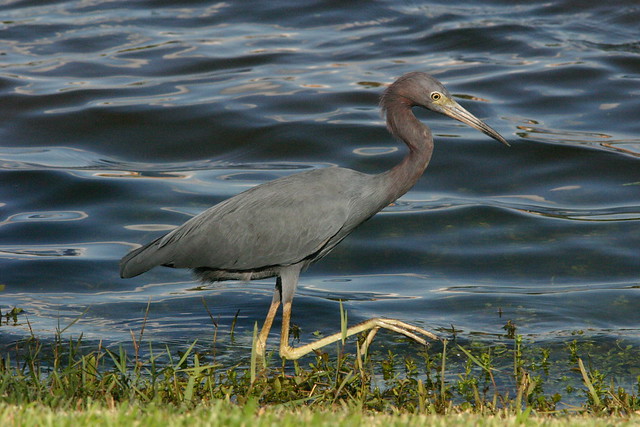
This one, struggling to subdue a siren* which it had just captured, appears to be quite uniformly blue.
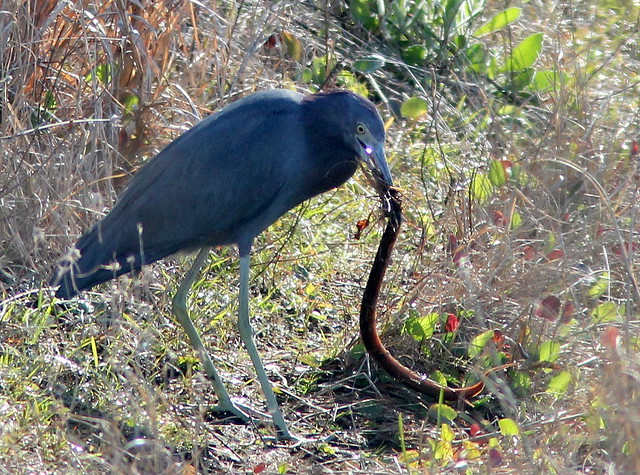
The Little Blue Heron assumes a characteristic foraging posture, moving slowly with frequent pauses, the tip of its bill just touching the water.
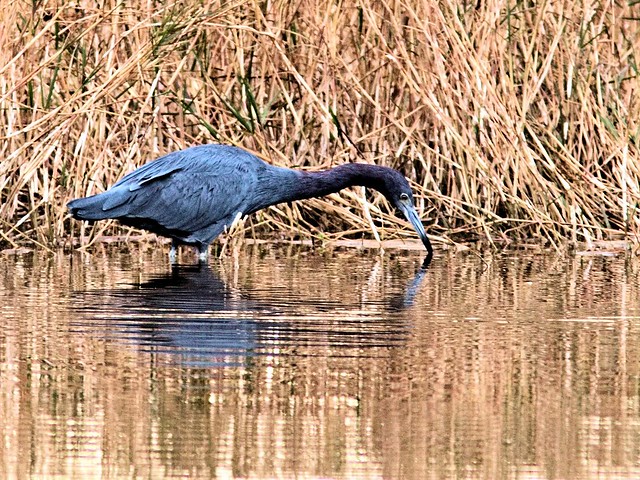
For the first year of its life, the Little Blue Heron is pure white. Its light blue dark-tipped bill and greenish legs help distinguish it from the white egrets. This bird is very young:
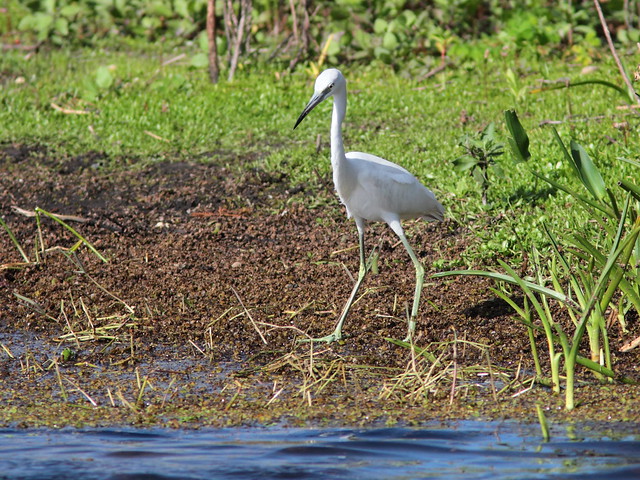
At about a year of age, it molts into the dark adult plumage.
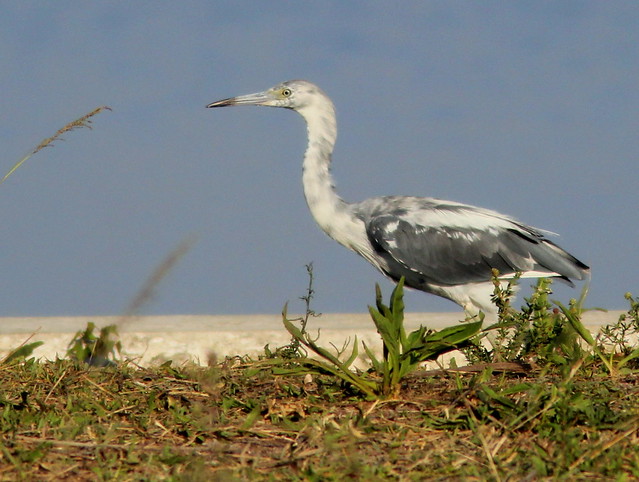
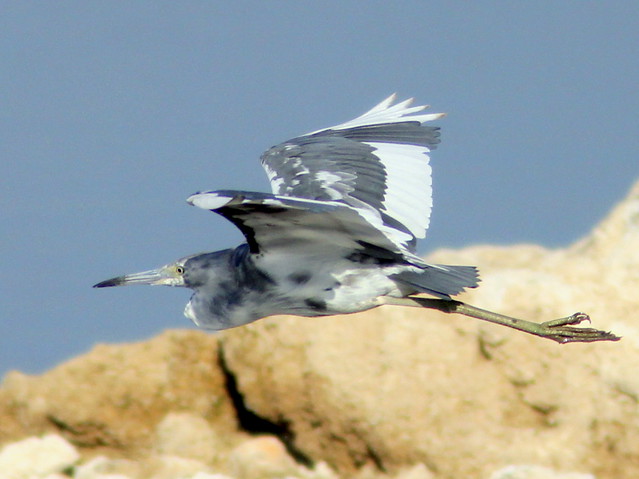
Usually solitary, these two were part of a group of 5 adult and one immature Liitle Blues that were feeding quite close together.
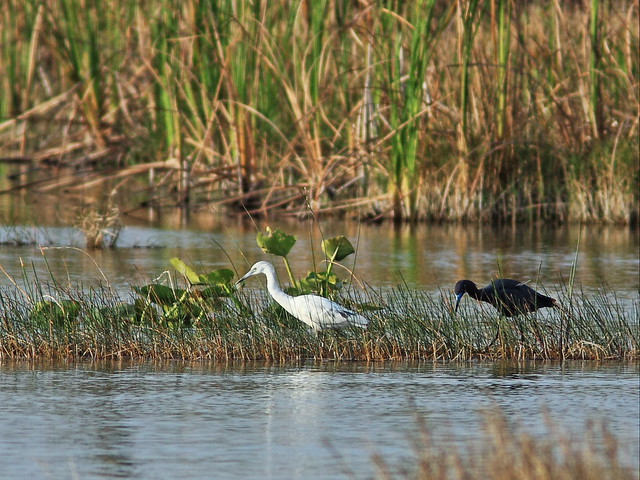
They sometimes travel in same-species flocks. This photo was taken from a great distance, but I liked the arrangement of the flying birds.

Immature Little Blue herons seem to be at the bottom of the heron pecking order. While herons of all species may vocalize or chase others that approach them too closely when they are hunting, the immature Little Blue Herons seem to be picked upon just for being in the vicinity of adults of the same species as well as Snowy and Great Egrets. I have not noticed this with Great Blue or Tricolored Herons, though they can get very cranky at times.
Even the Boat-tailed Grackles try to make their life miserable:
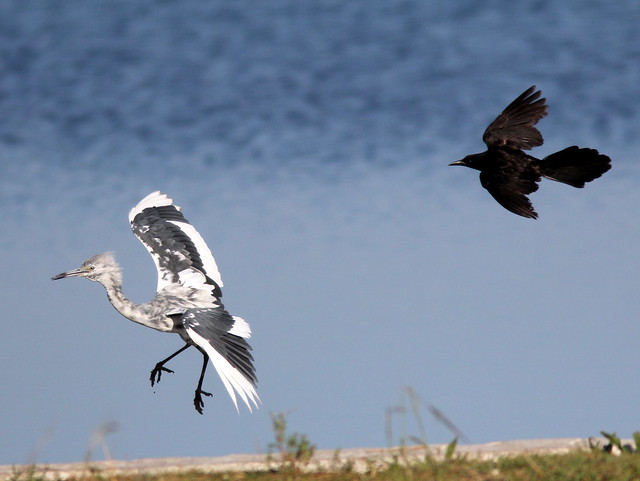
After posing in good light on a rock along the lake shore, this Little Blue Heron flew over to join a Tricolored Heron.
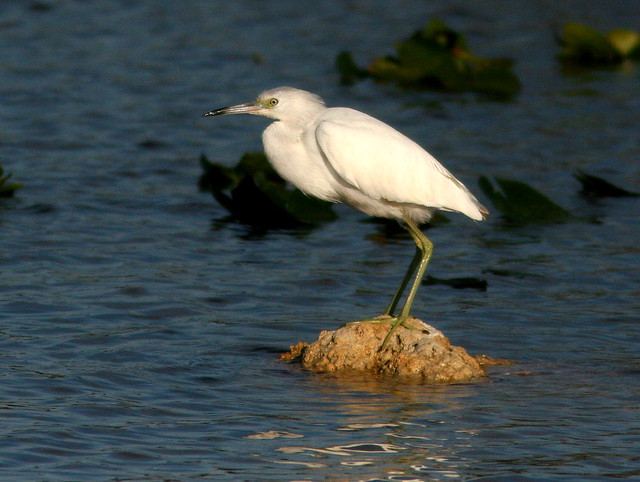
They foraged together with the sun behind them. I liked the way that back lighting emphasized the contours of the white heron, but it caused the Tricolored to be too heavily shadowed. I used fill flash with the Better Beamer flash extender on this shot, from about 30 - 40 feet away
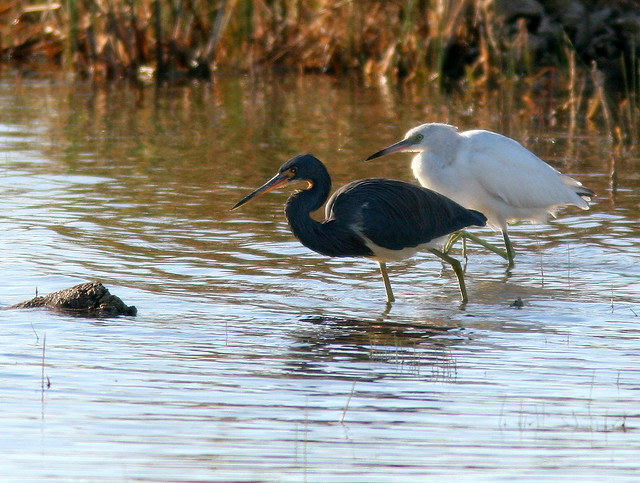
A white immature Little Blue Heron flew into the feeding territory of a blue adult. The adult confronted the youngster and chased it away, but it returned and attacked the adult. Then both wrestled in the high grass (my photos show only flailing wings), and the adult finally followed the younger bird for some distance until it left the area.

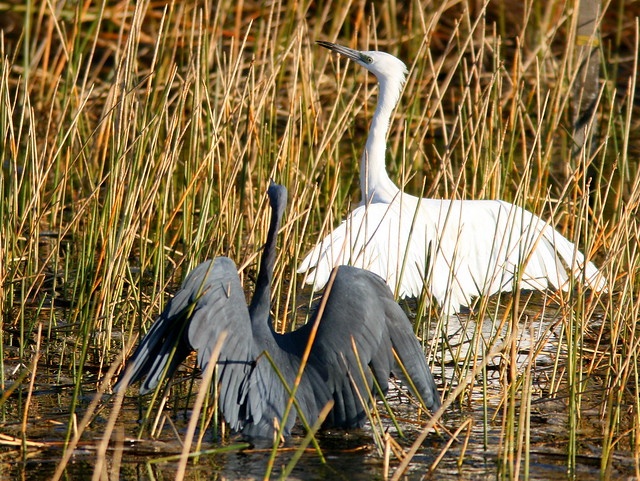
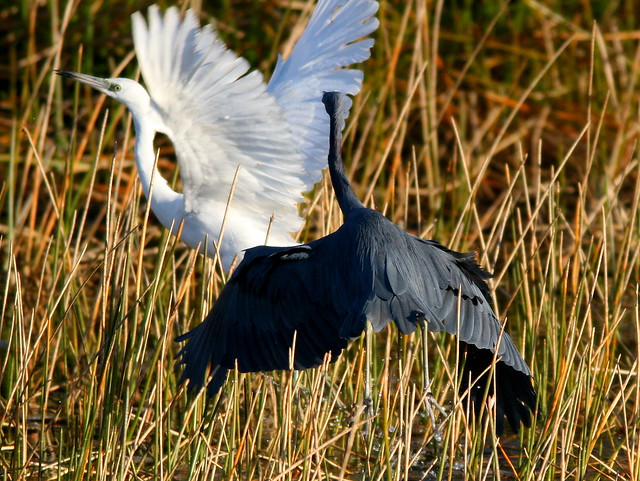
In this sequence, I first noticed two white herons engaged in what appeared to be a hostile encounter with much parrying and fluttering at the far edge of the Harbour Lakes water conservation impoundment. It did not look like courtship or mating behavior. As I raised my camera, a Great Egret flew in and intervened. The combatants were immature Little Blue Herons. One ended up mostly under water with the other standing straight up on top of its back. Upon arrival of the egret, the warring parties took off in different directions.
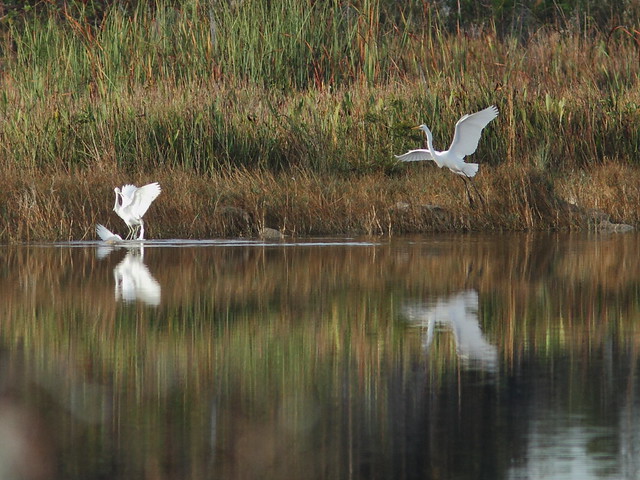

Note the size diffence betwee these two species. One is appropriately called "Little."
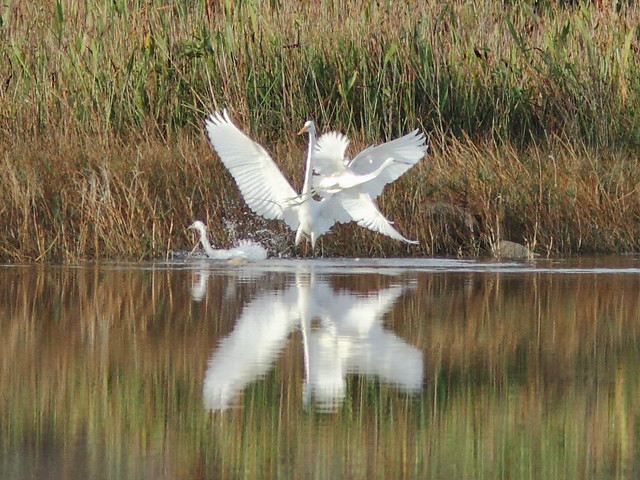
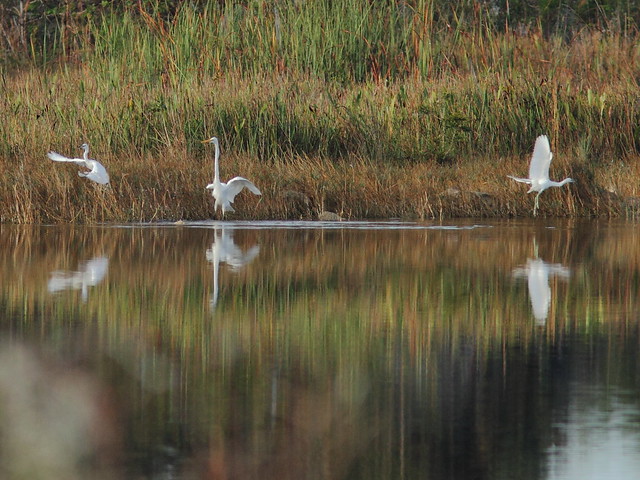
This video illustrates the feeding behavior of Little Blue and Tricolored Herons (if it fails to appear here, visit this link.)
*References:
edis.ifas.ufl.edu/uw168
There are two species of large, aquatic salamanders in Florida: Two-toed Amphiuma (Amphiuma means) and Greater Siren (Siren lacertina)
Both of these giant salamanders are often confused with eels. In fact, you may hear people call these salamanders "mud-eels" or "ditch-eels." However, eels are a type of fish with obvious fins running along their back and underside. Salamanders are amphibians. Amphibians have limbs and no fins. Also, giant salamanders are easily distinguished from aquatic snakes because their skin is smooth, slimy, and lacks scales.
www.uga.edu/srelherp/salamanders/sirlac.htm
The sirens are generally regarded as the most primitive living salamanders. The ecology and natural history of sirens is poorly known. All sirens share a conspicuous basic characteristic: the absence of rear limbs. Another notable characteristic is the presence of external gills throughout life. Sirens are completely aquatic, rarely emerging from water unless absolutely necessary. The absence of hindlimbs and the relatively weak forelimbs make overland travel virtually impossible. But if, for instance, a body of water dries up, sirens are forced to deal with a terrestrial existence. Their solution? Wait for a better day. Sirens can secrete a cocoon, of sorts, in which they can aestivate, for more than a year, until the pond refills with water.
i hope to see a little blue some day!
ReplyDeleteOh my, aren't they just gorgeous! Beautiful photography Ken, Lots of action and reflections, wonderful. An interesting video too. I also watched your spoonbills in Miramar, fantastic!
ReplyDeleteIncredible!!! Wow...you even managed to photograph the dappled immature/adult molting!! That in itself is wonderful!!! Wow.
ReplyDeleteSome simply gorgeous egret pictures there Ken. You have given us all some valuable tips and information on how to photograph both white and very dark birds. I especially like the formation photo.
ReplyDeleteGorgeous birds. Amazing photos as usual and the video was very interesting.
ReplyDeleteWow ! They are gorgeous !
ReplyDeleteThe little blue heron is one of my favorite herons. They are all beautiful shots, it is way too hard to choose a favorite, gorgeous photos.. Thank you for linking up your post. Have a happy Sunday!
ReplyDeleteLovely Herons, great photos as well.
ReplyDeleteThere is a blue heron that hangs out at my brother's pond, but he flies the second he says anyone rounding the corner of the machine shed. No luck catching him yet. You have a wonderful variety of pics here, plus I learned something.
ReplyDeleteI love herons...especially watching them fly. Your photos are lovely! I've come from Anni's and it's so great to meet you!
ReplyDeletewhat can I say but WOW!
ReplyDeleteSuch and interesting post, illustrated by great action photos!
ReplyDeleteFantastic photos and a really interesting story!
ReplyDeleteGreat photos and descriptions to go with them! I didn't know all these fascinating facts about these types of birds. I also didn't know they could resort to almost drowning another of their own species! Wow! I'm glad the Great Egret showed up to break up that fight. Nice reflections in those, too.
ReplyDeleteFantastic shots of birds in action.
ReplyDeleteAn excellent post Ken clearly showing the plumage changes from juvenile to adulthood.
ReplyDeleteGreat collection of Herons and beautiful photos.
ReplyDeleteVery good post!!!
ReplyDeleteSuch an informative post! I enjoyed learning about the sirens (my grandson would love that part!) and about the gorgeous Little Blue Heron. They have such a lovely dark color as an adult and such snowy white as a youngster. really glad to see both.
ReplyDeleteHi Kenneth This is a wonderful informative post with marvelous photographs and video. I found it interesting to see the green legs of the young Little Blue because as you say it is otherwise very like a Little Egret. Of course I would not make that mistake here as we don't have Little Blues here!!! Thanks for all the work that went into making this post.
ReplyDeleteWonderful post and such fantastic series of photos!
ReplyDeleteVery interesting post with a beautiful series of photos!
ReplyDelete